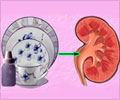New study partly explains the increase in kidney stones prevalence, particularly among children.
- Some oral antibiotics significantly increase the risk of developing kidney stones.
- Children are the most affected, as they are prescribed more antibiotics than adults.
- Oral sulfas, cephalosporins, fluoroquinolones, nitrofurantoin, and broad-spectrum penicillins were associated with increased risk of kidney stones.
Kidney stones
Kidney stones are hard mineral and salt deposits that form inside your kidneys. They can affect any part of your urinary tract from the kidneys to the bladder. Kidney stones are often manageable and easy to treat, if identified early. While these are common in adults, the occurrence in children was previously rare. However, now there seems to be a rise in the prevalence of kidney stones among children. "The overall prevalence of kidney stones has risen by 70 percent over the past 30 years, with particularly sharp increases among adolescents and young women," said study leader Gregory E. Tasian, MD, MSCE, a pediatric urologist at Children's Hospital of Philadelphia (CHOP).Co-author Michelle Denburg, MD, MSCE, a pediatric nephrologist at CHOP, added, "The reasons for the increase are unknown, but our findings suggest that oral antibiotics play a role, especially given that children are prescribed antibiotics at higher rates than adults."
Study overview
Data was collected from the electronic health records from the United Kingdom. The study included 13 million adults and children seen by general practitioners in the Health Improvement Network between 1994 and 2015. The research team analyzed prior antibiotic exposure for nearly 26,000 patients with kidney stones, and nearly 260,000 control subjects.Study findings
Five classes of oral antibiotics were associated with a diagnosis of kidney stones; these were: oral sulfas, cephalosporins, fluoroquinolones, nitrofurantoin, and broad-spectrum penicillins.- Patients who received sulfa drugs were more than twice as likely as those not exposed to antibiotics to have kidney stones.
- Patients who received broad-spectrum penicillins, the increased risk was 27% higher.
- The strongest risks for kidney stones were found in children and adolescents. While the risk of kidney stones decreased over time, the elevated level of antibiotics remained several years after antibiotic use.
Reference:
- Gregory E. Tasian1, Thomas Jemielita, David S. Goldfarb, Lawrence Copelovitch, Jeffrey S. Gerber, Qufei Wu and Michelle R. Denburg "Oral Antibiotic Exposure and Kidney Stone Disease" Journal of the American Society of Nephrology (2018), doi: 10.1681/ASN.2017111213
Source-Medindia















